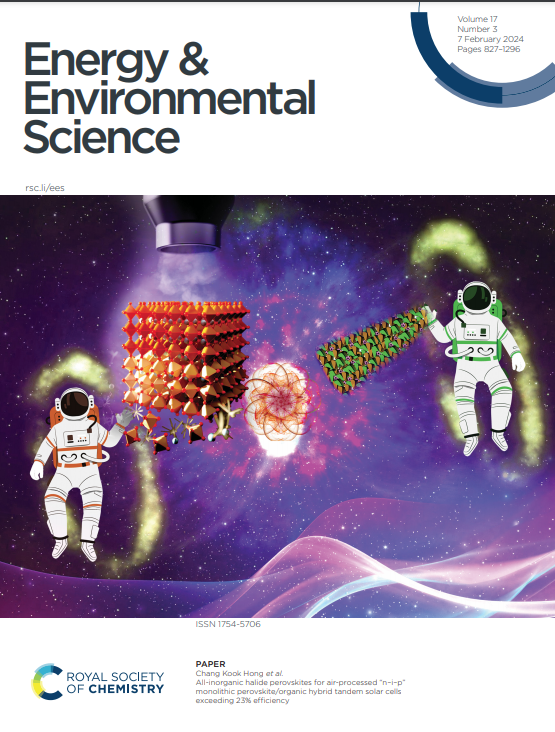垂直排列的赤铁矿纳米片,具有可控暴露的 (110) 面,用于合成氨,具有超过 2.5 A cm-2 的高法拉第效率
IF 32.4
1区 材料科学
Q1 CHEMISTRY, MULTIDISCIPLINARY
引用次数: 0
摘要
赤铁矿因其良好的坚固性和丰富的地球元素含量而被广泛研究用于前景广阔的(光)电催化,但其在安培级电流密度下的法拉第效率仍不尽如人意,因此其在氨的电化学合成中的应用一直受到困扰。在此,我们通过简单的原位电化学重构策略制备了垂直排列的赤铁矿纳米片(记为 Fe2O3-NS)阵列,其高宽比(110)晶面暴露在外,在超过 2.5 A cm-2 的电流密度下,氨产量达到前所未有的 189.05 mg h-1 cm-2,法拉第效率约为 95%,优于最先进的铁基电催化剂。实验和理论均表明,Fe2O3-NS 裸露的(110)晶面有利于电催化过程中中间物种的吸附和活化,其垂直排列的纳米片阵列提供了丰富的活性位点和有利的电荷转移通道。最终得到的赤铁矿纳米片阵列被用作硝酸锌电池的阴极,放电功率密度高达 36.2 mW cm-2。本文章由计算机程序翻译,如有差异,请以英文原文为准。
Vertically aligned hematite nanosheets with (110) facets controllably exposed for ammonia synthesis with high faraday efficiency beyond 2.5 A cm-2
Hematite has been widely investigated for promising (photo)electrocatalysis due to its good robustness and abundant element content in earth, but its application in electrochemical synthesis of ammonia has been still plagued by unsatisfactory Faraday efficiency at ampere-scale current density. Herein we prepared a vertically aligned hematite nanosheet (denoted as Fe2O3-NS) arrays with a high-aspect-ratio (110) crystal facet exposed by one simple in situ electrochemical reconstruction strategy, which delivers unprecedentedly efficient ammonia yield of 189.05 mg h-1 cm-2 companying with Faradaic efficiency of ca. 95% at the current density of exceeding 2.5 A cm-2, outperforming the state-of-the-art Fe-based electrocatalysts. It is experimentally and theoretically revealed that the exposed (110) crystal plane of Fe2O3-NS is favorable for the adsorption and activation of intermediate species during the electrocatalysis, and its vertically aligned nanosheet arrays provide abundant active sites and favorable charge transfer channels. The as-obtained hematite nanosheet arrays were finally employed as cathode of one Zn-nitrate battery to deliver an outstanding discharge power density of 36.2 mW cm-2.
求助全文
通过发布文献求助,成功后即可免费获取论文全文。
去求助
来源期刊

Energy & Environmental Science
化学-工程:化工
CiteScore
50.50
自引率
2.20%
发文量
349
审稿时长
2.2 months
期刊介绍:
Energy & Environmental Science, a peer-reviewed scientific journal, publishes original research and review articles covering interdisciplinary topics in the (bio)chemical and (bio)physical sciences, as well as chemical engineering disciplines. Published monthly by the Royal Society of Chemistry (RSC), a not-for-profit publisher, Energy & Environmental Science is recognized as a leading journal. It boasts an impressive impact factor of 8.500 as of 2009, ranking 8th among 140 journals in the category "Chemistry, Multidisciplinary," second among 71 journals in "Energy & Fuels," second among 128 journals in "Engineering, Chemical," and first among 181 scientific journals in "Environmental Sciences."
Energy & Environmental Science publishes various types of articles, including Research Papers (original scientific work), Review Articles, Perspectives, and Minireviews (feature review-type articles of broad interest), Communications (original scientific work of an urgent nature), Opinions (personal, often speculative viewpoints or hypotheses on current topics), and Analysis Articles (in-depth examination of energy-related issues).
 求助内容:
求助内容: 应助结果提醒方式:
应助结果提醒方式:


